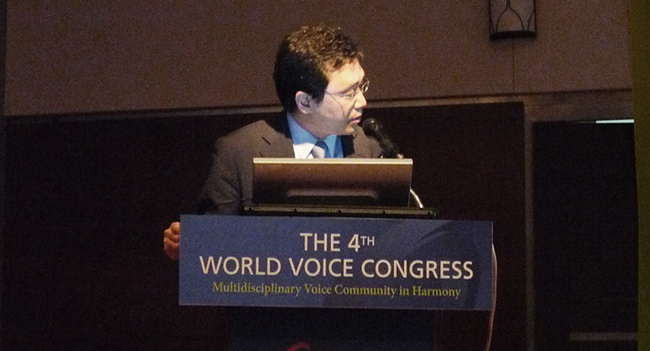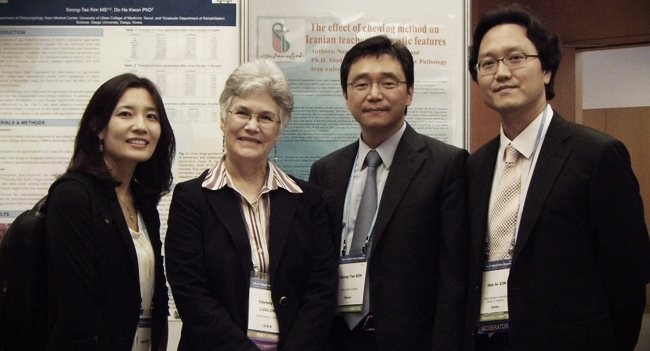예송음성센터 김형태원장은 2010년 9월 6일 부터 9일까지 서울 코엑스에서 열린 제4회 세계음성학회에서 패널세션 주제발표와 새로운 검사방법에 대한 연제발표를 시행하였습니다.
이번 세계음성학회는 전세계적인 음성학계의 석학들이 모인자리로서 약 400명의 외국 학자들과 국내외적으로 800여명이 참여한 세계적인 학술대회입니다.
이번 세계음성학회에서 "Aging Voice(목소리의 노화)"라는 주제의 패널세션에서 "Epidemiology and Clinical Characteristics of Presbylaryngis(노인성후두의 발병율과 임상적인 특징)"이란 제목으로 주제발표가 있었으며, 또한 자유연제시간에는 예송음성센터에서 최초로 새롭게 개발한 " Multichannel phonokinetic evaluation system(MPES) (발성역학적 다차원측정기)"에 대한 임상연구결과를 발표하는 자리를 갖었습니다.
이번 연제발표에서는 예송음성센터에서 최초로 개발한 발성역학적 다차원측정기에 대한 임상경험과 결과를 바탕으로 현재까지 음성전문인들에서 진단에 어려움이 있었던 발성패턴의 이상과 기능적 발성장애를 객관적이고 과학적인 방법으로 측정하고 치료에 적용하여 발성패턴변화에 시행할 수 있었던 결과발표가 이루어진 자리였습니다.
특히 예송음성센터에서 시행하고 있는 앞선 최첨단 진단장비와 기술에 대해 세계 여러 석학들에게 우리나라의 앞선 음성의학분야의 의료기술을알릴 수 있는 좋은 기회가 되었습니다.


Epidemiology and Clinical Characteristics of Presbylaryngis
Hyung-Tae Kim
Institute of Performing Art Medicine, Yeson Voice Center, South Korea
htkim@yesonvc.com
An early British professional voice user observed the aged man, “turning again toward childish treble, pipes and whistles in his sound” (Shakespeare, As You Like It, Act 2, Scene 7). The perceptual characteristics of the voice in senescence are commonly accepted to include diminished volume, breathiness, relatively high pitch, diminished flexibility, and perhaps tremulousness.
The most widely reported figure of 12% vocal dysfunction in geriatric population has been accepted and prevalence of perceived dysphonia was about 20%. The hoarseness is popular symptoms in geriatric population. The most common cause of hoarseness was benign laryngeal disease followed by malignant lesions, vocal fold paralysis, laryngopharyngeal reflux, function dysphonia, and presbyphonia.
In the clinical characteristics, among the laryngeal changes are ossification and calcification of cartilage, erosion of articular surfaces, histological changes of connective tissues, vocal fold atrophy, edema, glottal gap, laryngeal tension and irregularity of vocal fold vibration. Laryngeal imaging study showed that prominence of the vocal process during respiration and vocal fold bowing and the presence of spindle-shaped gap during phonation were significantly more common in the presbylaryngis.
In the acoustic characteristics, Harmonics-to-Ratio was found to be a more sensitive index of vocal function than jitter and shimmer in the geriatric population.
This session of panel also will discuss the vocal fold dynamics of presbylaryngis with high-speed videoendoscopy and diagnostic characteristics of visualizing laryngeal image. Issues that arise while examining the acoustic and aerodynamic indexes will also be taken up by this panel.
New diagnostic evaluation of phonokinetic aspect for professional voice users
Institute of Performing Art Medicine, Yeson Voice Center, South Korea
Backgrounds: There have been many trials to characterize the activity patterns of phonatory muscles during classical singing. It can be valuable diagnostic aspects to substantiate the muscle usage during inhalation and phonation and to investigate the relationship to changes in pitch and vocal loudness. The aim of this study was to evaluate the feasibility of newly developed multichannel phonokinetic evaluation system (MPES) for the complex phonatory functions during classical singing.
Material and Methods: 11 professional opera singers ( 3 male, 8 females) participated. MPES simultaneously evaluated the multichannel signals from voice, airflow, chest and abdominal respiration, EKG and surface electromyographic activity (EMG) that was recorded from bilateral trapezius(TZ), masseter (MM), geniohyoid(GH), Suprahyoid (SH), thyrohyoid (TH), and sternocleidomastoideus (SCM). During classical singing, videocamera captured whole performances of three singing tasks and synchronized with other signals and displayed the EMG amplitude of all muscles with respiratory events, voice signal and EKG.
Results: GM and MM showed correlated activity patterns during phonation by classical singers. Substantial muscle activity was observed in neck during singing. The activity of GM showed non consistent task-based difference in EMG activity for high pitched singing tasks even though the activity of other muscles in neck was markedly increased when sustained sound in the high pitch. 3 singers who had had pitch instability and intermittent dysphonia during classical singing showed discrepancy of activity of TZ , SH , and TZ.
Conclusions: This new phonokinetic evaluation system can be used a complementary evaluation of the phonatory pattern and substantiated the phonatory muscle usage and kinetic aspect of respiratory phasing during classical singing.
Keywords: classical singer, phonatory pattern, surface EMG, professional voice